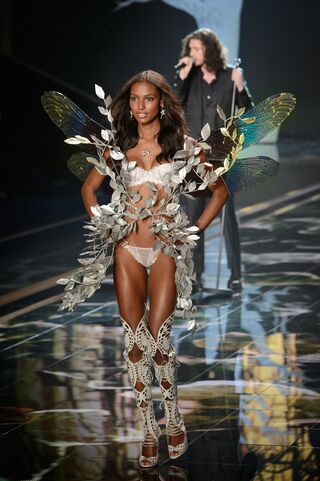Consumer Behavior
The Science Supporting Victoria's Secret's Big Changes
Ditching "Angels" in favor of a broader representation of women is a good move.
Posted June 18, 2021 Reviewed by Ekua Hagan
Key points
- Victoria's Secret announced it is replacing its cohort of “Angels” with a diverse and accomplished new set of models and spokespeople.
- Between 1995 and 2018, as U.S. women were becoming heavier, the Victoria's secret Angels were becoming even thinner.
- Exposure to the “thin ideal” modeled by Victoria’s Secret Angels and others has been associated with increases in women’s body dissatisfaction.

Lingerie giant Victoria’s Secret recently announced it was replacing its cohort of “Angels” with a diverse and accomplished new set of models and spokespeople, including soccer star Megan Rapinoe and actor and producer Priyanka Chopra Jonas.
Since the announcement, media outlets have flooded the internet with headlines like, “Out With Angels” and “Bye Angels, Hello Athletes.” We’ve also seen reflections on how those ubiquitous angels and the out-of-reach beauty ideal they represented shaped the lives of multiple generations of women.
Victoria’s Secret’s massive rebranding effort may be “too little too late,” but from a psychological perspective, it’s a move in the right direction. Several decades of research have documented how the type of marketing strategy previously undertaken by Victoria’s Secret has the potential to negatively impact women’s mental and physical health. The Victoria’s Secret approach to defining beauty and desire was toxic for many women. Here are two, scientifically-backed reasons why.
1. Victoria’s Secret promoted an incredibly narrow, (mostly) unreachable body ideal for women.

Victoria’s Secret is certainly not alone in promoting an unrealistic body ideal. But the intense marketing of the Victoria’s Secret Angels contributed to a cultural environment in which the female body ideal became absurdly out-of-reach for nearly every woman.
The angels tended to be around five inches taller than the average American woman (that's around the 99th percentile for height). They were also extraordinarily thin, with very narrow waists and no visible cellulite. Some writers even accused the Victoria’s Secret Angels of having a “boob diversity” problem — showcasing only the type and size of breasts that typically come from having implants. Recent research demonstrated that between 1995 and 2018, as U.S. women were becoming heavier, the Angels were becoming even thinner.
There’s nothing wrong with thin bodies. Bodies come in all shapes and sizes. But when very thin bodies are the only bodies portrayed as desirable, that comes with psychological consequences.
One analysis of 25 different experiments found that even brief exposure to the “thin ideal” portrayed by models like the Victoria’s Secret Angels was associated with immediate increases in women’s body dissatisfaction. Body dissatisfaction is an important predictor of the onset of eating disordered behavior. It’s also psychologically painful.
Exposure to the tall, thin body ideal promoted by the Angels has also been linked to increases in depression, particularly among young women. Women who feel insecure about the size or shape of their bodies are more likely to seek out these types of idealized media images in order to determine how they compare to cultural body ideals. The result is a chronic feeling of falling short.
In some ways, there was nothing unusual about the Victoria’s Secret Angels. As far as models go, they were fairly typical. But Victoria’s Secret imagery so saturated our culture for so many years that their models likely played an outsized role in shaping women’s perceptions of female beauty and desirability. Victoria’s Secret contributed to a media landscape in which the true diversity of women’s bodies was invisible.
2. Victoria’s Secret promoted a culture in which women were viewed as sexual objects instead of full human beings.
For years, Victoria’s Secret has been a classic example of a marketing strategy built on portraying women as sexual objects. The implicit message in Victoria’s Secret stores, catalogues, and advertising was that women should choose their undergarments with one goal in mind: appearing sexually desirable to men. Martin Waters, the recently appointed chief executive of Victoria’s Secret, admitted that the rebranding was, in part, a move to change this approach. He explained, “We needed to stop being about what men want and to be about what women want.”
This is an important change. For decades, researchers have been documenting how the sexual objectification of women contributes to poor body image, eating disorders, anxiety, and depression. Objectification occurs when you are treated as little more than a body or collection of body parts, valued only to the extent that you are visually pleasing to others. The objectification of women strips away their humanity.
Research shows that sexualized women are viewed as less human. Exposure to objectified imagery of women can also lead women to internalize this perspective and begin to view themselves as sexual objects. This self-objectification predicts a wide range of negative psychological outcomes in girls and women, including low self-esteem, depression, self-injury, and eating disorders.
Victoria’s Secret did not limit itself to promoting objectified imagery of adult women. Its “Pink” line was routinely accused of targeting young girls. The American Psychological Association has linked the sexualization of girls with increases in girls' feelings of shame and anxiety.
The press release introducing the new “Victoria’s Secret Collective” (the group of spokeswomen chosen for their accomplishments rather than their body shape) also announced that Victoria’s Secret will launch a global fund for women’s cancers. This undertaking will fund research projects on cancer treatments and tackle gender and racial inequities in cancer outcomes. That part of the announcement has gotten substantially less attention than the phasing out of the Angels, perhaps because it feels incongruent to associate Victoria's Secret with promoting women’s health.
Convincing women that Victoria’s Secret is an inclusive brand that treats women with respect may be an uphill battle. After all, Victoria’s Secret is far from offering inclusive sizing. At the time of writing this post, I checked out a pair of cotton pajamas on the Victoria’s Secret website. The largest size they offered for the pajamas was XXL. Their “essential legging” maxed out at a size 16 — below the average size of a woman in the U.S.

Several years ago, I was walking in a mall and noticed that Victoria’s Secret was selling a cosmetics bag with the words “Never Enough” in bold print on the front. Something struck me about it and I snapped a photo. For years now, as a brand, Victoria’s Secret has contributed to women feeling as though they will never be enough simply because they will never have the body of an “Angel.” Could this turnabout by Victoria's Secret move our culture in a more positive direction? I guess we’ll have to wait and see.




